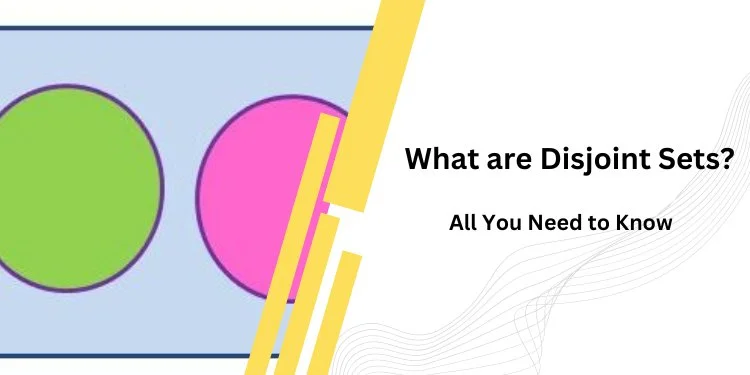Table of Contents
ToggleIntroduction
Computer science and data structures are vast and complex areas of study, constantly evolving and offering new solutions to various problems. One such concept that has gained significant importance in recent years is that of disjoint sets. This term refers to a mathematical concept that deals with the partitioning and connectivity of data elements. To better understand the significance of disjoint sets, it’s important to first understand what they actually are. In simple terms, a disjoint set is a collection of sets in which no two sets have any common elements. These individual sets are also known as disjoint subsets or non-intersecting subsets.
The main idea behind using disjoint sets is to categorize data elements into distinct groups, making it easier to analyze and manipulate them. The applications of disjoint sets extend far beyond just computer science. They have proven to be incredibly useful in various fields such as social network analysis, image processing, and even genetics.
Understanding Disjoint Sets

At its core, a disjoint set is a data structure that represents a group of sets that do not share any common elements. Each element in the disjoint set is assigned to one and only one of these sets, making them completely separate and non-overlapping. This concept is often used in computer science, with the primary objective being to efficiently manage and manipulate these sets through various operations such as union and find. One of the key advantages of using a disjoint set is its ability to easily identify the relationships between different elements within the sets.
This allows for quick and efficient computations when performing operations like finding the parent or root element of a given element, or merging two sets together by creating a new parent element. In order to efficiently represent these sets, various data structures such as arrays, trees, or graphs can be used. Each of these structures has its own advantages and disadvantages, depending on the specific application and requirements.
Representation of Disjoint Sets

When working with disjoint sets, there are multiple methods that can be used to represent them. Two common approaches are through the use of arrays and trees. In the array-based method, each element within the set is assigned a distinct identifier. These identifiers are then organized into an array structure, where the index of each element corresponds to its position within the set. The value stored at each index represents the parent of that element within the set. On the other hand, in the tree-based approach, sets are represented as hierarchical trees.
Each element in the set has a pointer to its parent node, which ultimately leads to the representative element for that particular set. This representation allows for efficient navigation and operations on disjoint sets by utilizing pointers and a tree structure rather than an array. Both methods have their advantages and limitations depending on the specific use case and requirements.
Key Operations on Disjoint Sets

MakeSet(x): Creates a new set containing the element x.
Union(x, y): Unites the sets containing elements x and y into a single set.
Find(x): Determines the representative element (root) of the set containing x.
Have a look at the following: data structures in java
Applications of Disjoint Sets

Kruskal’s Minimum Spanning Tree Algorithm: Disjoint sets find application in algorithms like Kruskal’s, where they efficiently detect and manage cycles in a graph, ensuring the formation of a minimum spanning tree.
Connected Components in Graphs: Disjoint sets help identify connected components in a graph, where each component is a set of vertices that are connected to each other but not to vertices in other components.
Dynamic Equivalence Problem: The problem of dynamic equivalence involves determining if two elements in a set are equivalent based on certain criteria. Disjoint sets facilitate this task efficiently.
Algorithms for Disjoint Sets
Union-Find (or Disjoint-Set Union) Data Structure: The data structure being described is highly efficient in performing both union and find operations, allowing for the maintenance of sets within a connected structure. This means that it is able to efficiently connect different elements together while also quickly finding specific elements within the structure. To achieve this level of efficiency, the data structure utilizes two commonly used optimization techniques: path compression and union by rank.
These techniques work together to further optimize the performance of the data structure by reducing the time and resources needed for both union and find operations. Path compression involves restructuring the connections within the data structure in a way that minimizes the length of paths between elements, making it easier and faster to locate specific elements. Additionally, union by rank prioritizes merging smaller sets into larger ones, preventing imbalanced structures and promoting more efficient operations overall. By incorporating these optimization techniques, this data structure is able to efficiently manage and manipulate sets within a connected structure, making it an invaluable tool for various applications.
Tarjan’s Off-line Least Common Ancestors Algorithm: In order to efficiently determine the least common ancestors of pairs of nodes within a tree, this algorithm makes use of disjoint sets. Disjoint sets are a data structure that allows for the grouping and organization of elements into non-overlapping subsets. By utilizing this approach, the algorithm is able to efficiently search for and identify the shared ancestors between two given nodes. The concept of “least common ancestor” refers to the closest node in a tree that is an ancestor to both given nodes. This can often be a complex and time-consuming task, especially in large trees with many levels and branches.
However, by implementing disjoint sets, the algorithm is able to narrow down the search space and eliminate irrelevant nodes, ultimately leading to a more efficient and accurate determination of the least common ancestor. Furthermore, this approach offers additional benefits such as scalability and flexibility. As disjoint sets can easily handle large amounts of data without compromising on performance, this algorithm can be applied to trees of varying sizes and complexities.
Conclusion
In conclusion, it can be said that disjoint sets offer a highly sophisticated and effective approach to tackling problems related to partitioning and connectivity. These sets have found widespread use in various fields of computer science, ranging from graph algorithms to dynamic equivalence problems.
By grasping the fundamental concepts and principles behind the data structures and algorithms utilized in disjoint sets, one can develop highly efficient solutions for a diverse range of computational challenges. As we delve into the complex world of computer science, the concept of disjoint sets serves as a shining example of the immense potential of structured and optimized problem-solving techniques.
Frequently Asked Questions(FAQs)
What are Disjoint Sets in computer science?
Disjoint sets refer to a collection of sets where no two sets have any element in common. Each element belongs to only one set, and the primary goal is to efficiently represent and manipulate these sets, allowing operations such as union and find.
How are Disjoint Sets represented?
Disjoint sets can be represented using various data structures. Two common methods are the array-based approach, where each element has a unique identifier and sets are represented as arrays, and the tree-based approach, where sets are represented as trees, with each element having a parent pointer.
What are the key operations on Disjoint Sets?
MakeSet(x): Creates a new set containing the element x.
Union(x, y): Unites the sets containing elements x and y into a single set.
Find(x): Determines the representative element (root) of the set containing x.
Where are Disjoint Sets used in algorithms?
Disjoint sets find applications in algorithms such as Kruskal’s Minimum Spanning Tree Algorithm, where they efficiently manage cycles in a graph. They are also used in identifying connected components in graphs and solving the dynamic equivalence problem.
What is the Union-Find data structure?
The Union-Find (or Disjoint-Set Union) data structure is commonly used to implement operations on disjoint sets. It efficiently performs union and find operations, maintaining sets in a connected structure. Optimization techniques like path compression and union by rank are often applied.
Can you provide an example of a problem where Disjoint Sets are applied?
Consider the problem of finding the minimum spanning tree in a graph using Kruskal’s algorithm. Disjoint sets are used to efficiently detect and manage cycles in the graph, ensuring the formation of a minimum spanning tree.
How do Disjoint Sets contribute to efficient algorithm design?
Disjoint sets contribute to algorithm efficiency by providing a structured way to handle partitioning and connectivity problems. Their application in various algorithms ensures optimized solutions for tasks such as graph analysis and dynamic equivalence determination. Understanding and utilizing disjoint sets enhance the overall efficiency of algorithm design.













